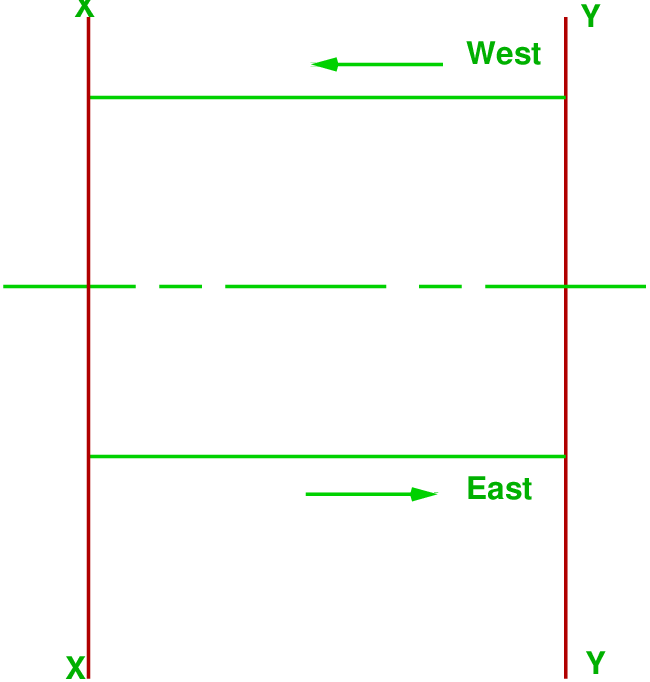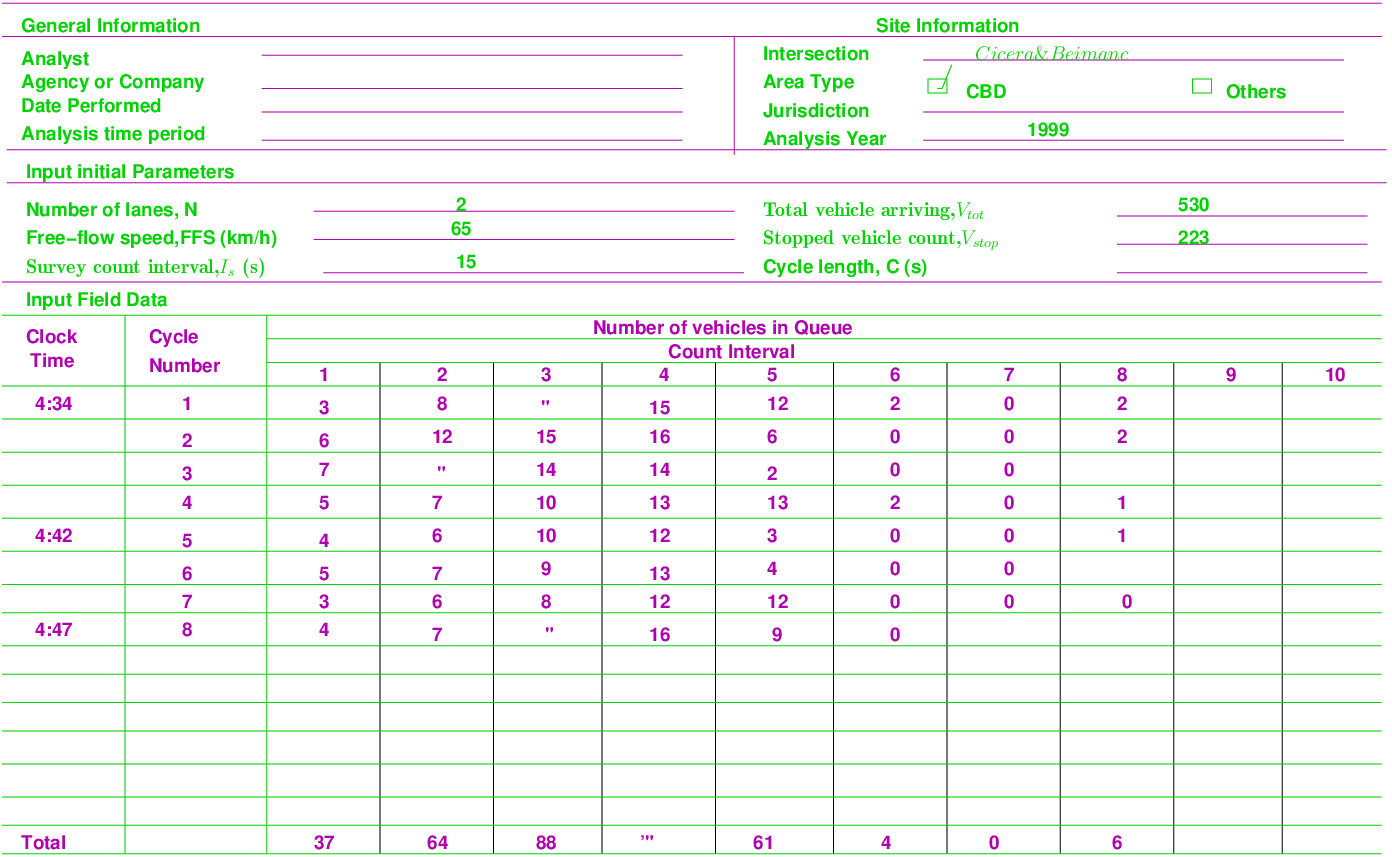Measurement along a Length of Road
Lecture Notes in Transportation Systems Engineering
Contents
______________________________________________________________________
1 Overview
This is normally used to obtain variations in speed over a stretch of road. Usually the stretch
will be having a length more than 500 meters. We can also get speed ,travel time and delay.
Speed and travel time are the most commonly used indicators of performance for traffic
facilities and networks. Delays are often used to measure the performance of traffic flow at
intersections.
2 Travel time study
Travel time is the elapsed time it takes for a vehicle to traverse a given segment of a street.
Travel time studies provide the necessary data to determine the average travel time.
Combined with the length of the corridor under study, this data can be used to produce
average travel speed. Travel time and delay are two of the principal measures of roadway
system performance used by traffic engineers, planners and analysts. Since vehicle speed is
directly related to travel time and delay, it is also an appropriate measure-of-performance to
evaluate traffic systems.
A study conducted to determine the amount of time required to traverse a specific route or
section of a street or highway. The data obtained provide travel time and travel speed
information but not necessarily delay. This term is often used to include speed and delay
study. Travel time may be defined as the total elapsed time of travel, including stop and delay,
necessary for a vehicle to travel from one point to another point over a specified route under
existing traffic condition.
3 Delay studies
Delay is defined as an extra time spent by drivers against their expectation. Delay can have
many forms depending on different locations. A study made to provide information concerning
the amount, cause, location, duration and frequency of delay as well as travel time and similar
value. The time lost by traffic due to traffic friction and traffic control device is called
delay.
4 Types of Delay
- Congestion delay- Congestion delay is the delay caused by the constricting or
slowing down effect of overloaded intersections, inadequate carriageway widths,
parked cars, crowded pavement and similar factor.
- Fixed Delay- The delay to which a vehicle is subjected regardless of the amount
of traffic volume and interference present.
- Operational Delay-The delay caused by interference from other component of the
traffic stream. Examples include time lost while waiting for a gap in a conflicting
traffic stream, or resulting from congestion, parking maneuvers, pedestrians, and
turning movement.
- Stopped Delay- The time a vehicle is not moving.
- Travel Time Delay- The difference between the actual time required to traverse
a section of street or highway and the time corresponding to the average speed
of traffic under uncongested condition. It includes acceleration and deceleration
delay in addition to stopped delay.
- Approach Delay -Travel time delay encountered to an approach to an intersection.
5 Purpose of travel time and Delay Studies
- The purpose of a Travel Time and Delay Study is to evaluate the quality of traffic
movement along a route and determine the locations, types, and extent of traffic
delays by using a moving test vehicle.
- This study method can be used to compare operational conditions before and
after roadway or intersection improvements have been made. It can also be
used as a tool to assist in prioritizing projects by comparing the magnitude of
the operational deficiencies (such as delays and stops) for each project under
consideration.
- The Travel Time and Delay Study can also be used by planners to monitor level
of service for local government comprehensive plans.
- The methodology presented herein provides the engineer with quantitative
information with which he can develop recommendations for improvements
such as traffic signal re-timing, safety improvements, turn lane additions, and
channelization enhancements
6 Method for obtaining travel time and delay study
- Floating Car Method: Floating car data are positions of vehicles traversing city
streets throughout the day. In this method the driver tries to float in the traffic
stream passing as many vehicles as pass the test car. If the test vehicle overtakes
as many vehicles as the test vehicle is passed by, the test vehicles should, with
sufficient number of runs, approach the median speed of the traffic movement on
the route. In such a test vehicle, one passenger acts as observer while another
records duration of delays and the actual elapsed time of passing control points
along the route from start to finish of the run.
- Average Speed Method: In this method the driver is instructed to travel at a
speed that is judge to the representative of the speed of all traffic at the time.
- Moving-vehicle method: In this method, the observer moves in the traffic
stream and makes a round trip on a test section. The observer starts at
section, drives the car in a particular direction say eastward to another section,
turns the vehicle around drives in the opposite direction say westward toward
the previous section again. Let, the time in minutes it takes to travel east
(from X-X to Y-Y) is ta, the time in minutes it takes to travel west (from
Y-Y to X-X) is tw, the number of vehicles traveling east in the opposite
lane while the test car is traveling west be ma, the number of vehicles that
overtake the test car while it is traveling west be mo, and the number of
vehicles that the test car passes while it is traveling west from be mp.
The volume (qw) in the westbound direction can then be obtained from the expression
and
the average travel time in the westbound direction is obtained from
- Maximum-car method: In this procedure, the driver is asked to drive as fast as is safely
practical in the traffic stream without ever exceeding the design speed of the
facility.
- Elevated Observer method: In urban areas, it is sometime possible to station
observers in high buildings or other elevated points from which a considerable length of
route may be observed. These investigator select vehicle at random and record; time,
location and causes-of-delay. The drawback is that it is sometime difficult to
secure suitable points for observation throughout the length of the route to be
studied.
- License Plate Method: when the amount of turning off and on the route is
not great and only over all speed value are to be secured, the license-plate
method of speed study may be satisfactorily employed. Investigator stationed at
control point along the route enters, on a time control basis, the license-plate
numbers of passing vehicles. These are compared from point to point along the
route, and the difference in time values, through use of synchronized watches,
is computed. This method requires careful and time-consuming office work
and does not show locations, causes, frequency, or duration of delay. Four
basic methods of collecting and processing license plates normally considered
are:
- Manual: collecting license plates via pen and paper or audio tape recorders
and manually entering license plates and arrival times into a computer.
- Portable Computer: collecting license plates in the field using portable
computers that automatically provide an arrival time stamp.
- Video with Manual Transcription: collecting license plates in the field using
video cameras or camcorders and manually transcribing license plates using
human observers.
- Video with Character Recognition: collecting license plates in the
field using video, and then automatically transcribing license plates and
arrival times into a computer using computerized license plate character
recognition.
- Photographic Method: This method is primarily a research tool, it is useful in studies
of interrelationship of several factors such as spacing, speeds, lane usage, acceleration
rates, merging and crossing maneuvers, and delays at intersections. This method is
applicable to a short test section only.
- Interview Method: this method may be useful where a large amount of material is
needed in a minimum of time and at little expense for field observation. Usually the
employees of a farm or establishment are asked to record their travel time to and from
work on a particular day.
- Highway Capacity Manual 2000 or (Cycle- based method): This method is
applicable to all under saturated signalized intersections. For over-saturated conditions,
queue buildup normally makes the method impractical. The method described here is
applicable to situations in which the average maximum queue per cycle is no more than
about 20 to 25 veh/ln. When queues are long or the demand to capacity ratio is near
1.0, care must be taken to continue the vehicle-in-queue count past the end of the
arrival count period, vehicles that arrived during the survey period until all of them have
exited the intersection.as detailed below. This requirement is for consistency
with the analytic delay equation used in the chapter text.method does not
directly measure delay during deceleration and during a portion of acceleration,
which are very difficult to measure without sophisticated tracking equipment.
However, this method has been shown to yield a reasonable estimate of control
delay.
The method includes an adjustment for errors that may occurred when this type of
sampling technique is used, as well as an acceleration-deceleration delay
correction factor Table 1. The acceleration-deceleration factor is a function of
the typical number of vehicles in queue during each cycle and the normal
free-flow speed when vehicles are unimpeded by the signal. Before beginning the
detailed survey, the observers need to make an estimate of the average free-flow
speed during the study period. Free-flow speed is the speed at which vehicles
would pass unimpeded through the intersection if the signal were green for an
extended period.be obtained by driving through the intersection a few times
when the signal is green and there is no queue and recording the speed at
a location least affected by signal control. Typically, the recording location
should be upstream about mid-block. Table 2 is a worksheet that can be used
for recording observations and computation of average time-in-queue delay
|
|
|
|
| Free-Flow Speed | ≤ 7 Vehicles | 8-19 Vehicles | 20-30 Vehicles |
|
|
|
|
| ≤ 60km∕h | 5 | 2 | 1 |
| 60-71 km/h | 7 | 4 | 2 |
| ≥ 71 km/h | 9 | 7 | 5 |
|
|
|
|
| |
Table 1: Acceleration-Deceleration Delay Correction Factor, CF (seconds)
Steps for data reduction
- Sum each column of vehicle-in-queue counts, then sum the column totals for
the entire survey period.
- A vehicle recorded as part of a vehicle-in-queue count is in queue, on average, for
the time interval between counts. The average time-in-queue per vehicle arriving
during the survey period is estimated.
where, Is = interval between vehicle-in-queue counts (s), ΣV iq = sum of
vehicle-in-queue counts (veh), V tot = total number of vehicles arriving during the
survey period (veh), and 0.9 = empirical adjustment factor. The 0.9 adjustment
factor accounts for the errors that may occur when this type of sampling technique
is used to derive actual delay values, normally resulting in an overestimate of
delay.
- Compute the fraction of vehicles stopping and the average number of vehicles
stopping per lane in each signal cycle, as indicated on the worksheet.
- Using Table 1, look up a correction factor appropriate to the lane group free-flow
speed and the average number of vehicles stopping per lane in each cycle. This
factor adds an adjustment for deceleration and acceleration delay, which cannot be
measured directly with manual techniques.
- Multiply the correction factor by the fraction of vehicles stopping,
and then add this product to the time-in-queue value of Step
2 to obtain the final estimate of control delay per vehicle.
6.0.1 Numerical Example
A test was conducted to determine the delay in an intersection. Table 3 presents a sample
computation on direct observation of vehicle-in-queue counts at the intersection. The traffic
signal at the intersection operates with a cycle time of 115 sec. The test was conducted on
the 2 lane road over a 15-min period, which is almost thirteen cycles . Count interval was
15-s. The total number of vehicle is 530 and the total number of stopped vehicle is 223.
Assume the free flow speed to be 65 km/h and the empirical adjustment factor 0.9
Solution:
- Number of lane, N=2
- Free-flow Speed, FFS =65 km/h
- Survey count interval, Is =15 sec
- Total vehicle in queue, ΣV iq = 371
- Total vehicles arriving, V tot = 530
- Stopped vehicles count, V stop = 223
- No of Cycle Surveyed, Nc=7.8
- Acc./Dec. correction factor, CF=4 (from Table 7.1)
- No. Of Vehicles stopped per lane each cycle
V stopNc × N =  = 14
= 14
- Fraction of vehicles stopping,
FV S =  =
=  = 0.42
= 0.42
- Time-in-queue per vehicle ,
dvq = (Is × )0.9 = 9.5sec
)0.9 = 9.5sec
- Acc./Dec. correction delay,
dad = FV S × CF = 0.42 × 4 = 1.7sec
- Control delay/vehicle,
d = dvq + dad = 11.2sec
7 Summary
The information assembled as part of this travel time and delay study forms a baseline for
future assessment. This study helps to determine the amount of time required to travel from
one point to another on a given route. Often, information may also be collected on the
locations, durations, and causes of delays. Good indication of the level of service and
identifying problem locations
Exercises
- It was observed that the inductive loop was on for 0.39, 0.46, 0.43, 0.47, 0.50,
0.51, 0.48, 0.46, 0.32, 0.44, 0.50, 0.45, 0.44 seconds during one minute interval.
If the effective length of a vehicle is 7 meters, compute the density.
- The on and off time (in sec) of a presence type detector are given below. Compute the
flow in veh/hr, occupancy in percentage, density in veh/km, time mean speed
and space mean speed in km/hr. Given that the duration of observation is 60
seconds, the length of the detector is 4 meters and the length of the vehicle is 5
meters.
|
|
|
| i | tion | tioff |
|
|
|
| 1 | 7.11 | 7.34 |
|
|
|
| 2 | 16.47 | 17.13 |
|
|
|
| 3 | 26.10 | 26.47 |
|
|
|
| 4 | 36.54 | 37.31 |
|
|
|
| 5 | 43.20 | 43.56 |
|
|
|
| 6 | 55.00 | 55.42 |
|
|
|
| |
References
- Highway capacity manual, 2000. chapter-16.
- Manual on uniform traffic studies, 2000. Topic No. 750-020-007 Travel Time and
Delay Study.
- Travel Time Data Collection Handbook. 2019.
- F D Hobbs. Traffic Planning and Engineering. Pergamon Press, 1979. 2nd
Edition.
- W S Hamburger J H Kell. Fundamentals of Traffic Engineering. 1989.
- Theodore M Matson, Wilbur S Smith, and Frederick W Hurd. Traffic
Engineering. McGraw Hill Book Company, New York, 1955.
Acknowledgments
I wish to thank several of my students and staff of NPTEL for their contribution in
this lecture. I also appreciate your constructive feedback which may be sent to
tvm@civil.iitb.ac.in
Prof. Tom V. Mathew
Department of Civil Engineering
Indian Institute of Technology Bombay, India
_________________________________________________________________________
Monday 21 August 2023 12:19:58 AM IST









